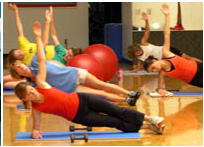 Holidays equal merriment and lots of good food. There is no need to feel guilty about occasionally indulging in some of your favorite holiday treats (peanut butter Hershey Kiss cookies are my favorite). However, with constant holiday parties and cookie exchanges, it can be very difficult to not overindulge. Here are a few tricks to preventing holiday sweets from sabotaging your weight loss efforts.
Holidays equal merriment and lots of good food. There is no need to feel guilty about occasionally indulging in some of your favorite holiday treats (peanut butter Hershey Kiss cookies are my favorite). However, with constant holiday parties and cookie exchanges, it can be very difficult to not overindulge. Here are a few tricks to preventing holiday sweets from sabotaging your weight loss efforts.At the Office
- Don't let food be the focus of work parties. Rather than organizing a cookie exchange or holiday lunch at work, try doing a Secret Santa Swap or ornament exchange. We are around enough food and sweets over the holidays; support your fellow employees by not sabotaging each other's weight loss efforts. Make a commitment with each other to "maintain not gain" over the holidays by promising to not bring in leftover cookies, pumpkin rolls and other sweets. A recent client of mine decided to ban her office's "Friday Potluck". Instead, she organized a "coffee social", offering several gourmet flavored coffees every Friday rather than unhealthy food. Everyone in the office appreciated the change (and I imagine the caffeine buzz upped productivity).
- If you can't convince people to stop bringing in their baked goods for months during the holidays, AVOID the break room altogether. Pack your lunch, and include lots of healthy snacks such as 100-calorie snack packs, high fiber cereal bars, and fruit. Keep your snacks nearby so you can eat regularly. If you let yourself get too hungry, it will be nearly impossible to keep yourself from stopping by the break-room for a quick cookie pick-me-up.
- Chew gum or have a few mints after your meal. This may help prevent the urge to grab another cookie or two from the holiday tray.
- Find alternative ways to pass the time. If your day is dragging, you may be tempted to grab a handful of M&M's while you catch up on emails. Instead, drink a cup of decaf coffee, tea, or flavored water. We often mistake boredom for hunger and turn to food for something to do. Often, a simple zero calorie drink will distract us enough to realize we weren't really hungry in the first place.
At the Party
- Chose your holiday drinks wisely. When attending holiday parties, avoid the fancy cocktails and stick to a basic martini, glass of wine or light beer. Each has about 90-120 calories. Meanwhile, eggnog has anywhere from 200-350 a glass while a a margarita has about 250 calories. The worst choice, a Mudslide tops the charts at 800 calories (equivalent to two large slices of greasy pizza)! A surprising holiday treat (and one of my personal winter favorites), a Guinness Draught with only 126 calories a bottle.
- NEVER go to a holiday party hungry. The chances of finding something healthy are slim. It is better to grab a healthy snack or meal beforehand and have a drink and a few of your favorite treats at the party. Overall you will consume far fewer calories and have less post-party guilt.
Finally, stick to your regular workout routine. By maintaining your muscle mass and scorching through calories during high intensity cardio, you can prevent holiday sabotage all together.





















